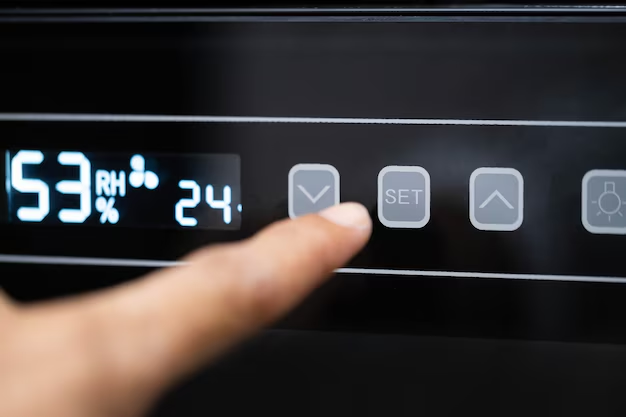How to Perfectly Adjust Your Digital Refrigerator Temperature Control
Picture this: you open your refrigerator to grab a cold beverage, and instead, you find your drinks are lukewarm or your lettuce is frozen solid. Such is the plight of an improperly adjusted refrigerator temperature. Fortunately, with modern refrigerators transitioning to digital temperature controls, you have the power to precisely manage the temperature inside your fridge. Mastering this can mean the difference between food spoilage and delightfully fresh ingredients. Let’s explore how to adjust these digital controls effectively, ensuring your refrigerator performs at its best.
Understanding the Basics of Refrigerator Temperature Control
What Is a Digital Temperature Control?
Gone are the days of manual dials and guesswork. Digital temperature controls in refrigerators provide a precise means to set and maintain the ideal temperature for your appliance. These controls typically allow you to choose a specific temperature setting in degrees Fahrenheit or Celsius, offering more accuracy than older models.
Some models feature intuitive digital panels where you can see the current temperature and make adjustments at the touch of a button. Understanding these controls is the first step in optimizing food storage.
Why Is Temperature Control Important?
Correct temperature settings are crucial for several reasons. Food preservation stands at the forefront. An ideal refrigerator temperature prolongs the freshness of your food, reducing waste and maintaining nutrition. Energy efficiency is another factor; a properly set refrigerator doesn’t have to overwork to maintain its environment, lowering electricity bills.
Pro Tip: Most experts suggest setting your refrigerator at approximately 37°F (3°C) and your freezer at about 0°F (-18°C) for optimal preservation and efficiency.
Step-by-Step Guide to Adjusting Your Digital Refrigerator Temperature
Familiarize Yourself with Your Refrigerator Model
Locate the User Manual: This should be your go-to resource for specific instructions related to your model. If misplaced, many manufacturers offer digital copies online.
Inspect the Control Panel: Examine your fridge’s control panel, and identify the buttons or display area where temperature settings are visible. Each model might slightly differ, but many have a clear interface with plus (+) and minus (-) signs to incrementally adjust temperatures.
Adjusting the Temperature
Access Control Settings: Typically, pressing a designated "Settings" or "Temperature" button on the control panel will activate the adjustment mode.
Set Desired Temperature: Use the increase (+) or decrease (-) buttons to reach the desired setting. Remember, slight adjustments can make a significant difference.
Monitor Changes: After setting, allow 24 hours for the refrigerator to adjust fully to the new temperature.
When to Adjust Your Temperature
- Seasonal Changes: As external temperatures rise or fall, consider adjusting your fridge’s setting to maintain efficiency.
- After High Traffic: Holidays or parties when the door is frequently opened might require a temporary cooler setting.
- Food Load Changes: A fuller or emptier fridge can impact the internal temperature and might require adjustments.
Common Challenges and How to Overcome Them
Temperature Not Changing
- Check for Obstructions: Ensure vents and fans are unobstructed for optimal airflow.
- Inspect Seals: Door seals should be airtight to maintain consistent temperatures. If a seal appears damaged, consider replacing it.
Food Sections Freezing or Not Staying Cool
- Avoid Overloading: A crowded fridge can restrict airflow, causing temperature imbalances.
- Proper Food Placement: Store meat and dairy closer to cold air vents, while sensitive produce can go further away to prevent freezing.
Enhanced Features of Modern Digital Controls
Today's advanced digital controls offer features to further fine-tune your refrigerator’s performance:
- Smart Features: Some fridges connect to smart devices, allowing remote monitoring and adjustments via smartphone apps.
- Door Alarms: Alerts sound if the fridge is left open to prevent unnecessary temperature fluctuations.
- Vacation Mode: During extended absences, this setting maintains energy efficiency while protecting your stored food.
Practical Tips for Optimal Refrigerator Performance
- 🥶 Regular Maintenance: Clean coils, check seals, and defrost regularly to keep your fridge running smoothly.
- 🌡️ Use Thermometers: Place thermometers in the fridge and freezer for accurate readings and ensure consistency.
- 📅 Regular Checks: Periodically assess your settings, especially after a restock or significant event.
Quick Tips Table
| Tip | Description |
|---|---|
| 🛠️ Routine Check-ups | Schedule periodic maintenance to ensure efficiency |
| 📏 Even Space | Allow air circulation by avoiding overcrowding |
| 🍎 Placement Matters | Store perishable items strategically based on cooling needs |
| 🌐 Utilize Smart Features | Leverage apps for remote adjustments if available |
Wrapping Up Your Temperature Control Mastery
Adjusting your refrigerator's digital temperature is a straightforward yet vital task that greatly affects your household’s efficiency and food quality. By mastering the digital controls, you gain peace of mind knowing your items are stored safely at the right temperatures. Plus, you save energy and prevent food waste.
Remember, while digital controls bring simplicity and precision, it is your attention and regular adjustments that truly optimize your refrigerator's performance. Whether you're dealing with fluctuating weather, regular use, or simply too many holiday leftovers, taking charge of your fridge’s temperature settings can reduce hassle and enhance efficiency all year round.
